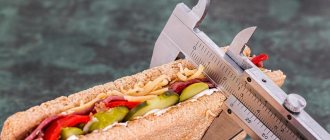If you want to lose weight properly, reduce the calorie content of your food. Everyone has heard this Frau, right? But what should you do if you don’t know what it is (does it seem like it’s written on the product packaging?), but you’re sure that you can lose weight gently? So let's figure out what calories are, why they need to be counted when losing weight, and how they are counted correctly in general.
What is needed for counting
People are divided into two types:
- Those who count calories
— And those who don’t count calories.
#1 – You can’t do without a kitchen scale
It is very difficult to judge by eye the weight of, for example, two pieces of meat of approximately the same size. A lean piece will weigh more than a sinewy piece with a bone. The difference can be twofold.
Let's not deceive ourselves or try to guess the weight. The accuracy of the kitchen scale weighing method will be the best way to determine the weight of food.
If you don’t have kitchen scales, you can order them on wildberries, amazon, aliexpress, mvideo, eldorado and other online stores. Read reviews and buy the model you like. This will be a good investment in your own health.
#2 – Calorie counting apps will make your life easier
Of course, you can write everything down in a notebook or constantly look at calorie tables, but apps will make the process easier and more interesting. More on this below.
#3 - Patience
Patience will also come in handy at first. Don't be discouraged if you find it difficult at first or if the counting takes a long time. At first we don’t like any unfamiliar task, then we get involved and begin to find our own thrill in it.
What you need to know
Nutrient Calories
You need to remember that the calorie content of foods consists of the calorie content of the macronutrients that make up them - these are proteins, fats, carbohydrates and fiber.
Table 1. Energy value of food macronutrients
| Amount of energy | |
| 1 g protein | 4 kcal |
| 1 g carbohydrates | 4 kcal |
| 1 g fat | 9 kcal |
| 1 g fiber | 1.5 kcal |
| 1 g alcohol (alcohol) | 7 kcal* |
*Please check the calorie content of a specific alcoholic product, as... it is an alcohol-containing solution.
In fact, these caloric values are average, but these numbers are enough to correctly estimate the energy intake.
Two apples from the same tree may have different caloric content and composition of proteins, fats, and carbohydrates. However, this difference can be neglected. No one will take their food to the laboratory to accurately find out the macro and micronutrient composition of food.
People have long used the method of counting calories for the purpose of gaining weight and losing weight. A large number of studies prove its effectiveness. You can easily count the caloric content of nutrients, as in the table above.
Dry and raw product
In what form should food be weighed - raw or cooked? Dry and cooked foods have the SAME calorie content, but DIFFERENT weight due to the water they contain.
When cooked, cereals take up water, increasing in volume; meat, on the contrary, releases water during heat treatment, decreasing in size.
For example, buckwheat absorbs water when cooked and increases in volume by about 3 times. Add 100 g of buckwheat, boil it and get 300 g.
The calorie content of buckwheat is 330 kcal per 100 g. After cooking, we get three times more product from water, which has zero calorie content. Thus, the calorie content of buckwheat cooked in water will be 110 kcal per 100 g.
Please be aware of this difference. If you boil a whole pan, then when weighing the portion, divide the calorie content by 3 to get the correct numbers.
The situation with meat is the opposite. Take a piece weighing 200 g and fry it in a frying pan. The meat shrinks, getting rid of water, and loses weight by almost 2 times. Let's assume that when baking we got 100 g of the dish.
The calorie content of lean pork is 250 kcal per 100 g. When baked, we will get the same calorie content, but already in 100 g.
Don't count the meat as it's cooked. Your fantasies about not getting enough protein are unfounded. Calculate the raw weight or multiply the weight of the finished product by 2, as in our example.
Don’t be lazy and weigh once the weight of dry cereals and the resulting porridge from it, as well as the weight of raw and cooked meat. Do this for each cooking method (cooking, frying, baking) you use to find out exactly how much the food is reduced or increased. Next, simply multiply or divide the weight of the finished dish by the resulting coefficient.
Another example - dry rice weighing 200 g boiled in water to 440 g (increased 2.2 times). To calculate the KBJU for an 80 g portion of boiled rice, I will divide the KBJU for dry rice by 2.2.
The calorie content of dry white rice is 344 kcal per 100 g. 100 g of boiled rice will contain 344/2.2 = 156 kcal. And in a serving of 80 g there will be 156 x 0.8 = 125 kcal.
Everyone cooks differently. The more water you add to the cereal, the more it will boil. The longer you cook pasta, the more water it absorbs. Therefore, everyone will have their own coefficients.
Nuances when weighing products
When weighing fruit, consider the weight of the peel. For example, in bananas it makes up a significant part - a third of the fruit; in pomegranate, the seeds and peel weigh more than half of the total mass. Fruits such as apples can be counted whole. The seeds and peel make up less than 10% of the fruit's weight.
We weigh chicken without bones, cottage cheese without packaging, eggs without shells, oranges without peel, etc.
With experience, you will understand what to consider and what not to consider.
About the system error
Even with a permanent error, such as not accounting for the raw/cooked meal difference, calorie counting will still work . If your weight does not change, you will simply adjust your caloric intake.
For example:
I want to gain more and I don’t know that when rice is cooked, it takes in water and swells 2.5 times. I eat a 120 g portion of rice every day, I count calories and BJU, as for rice weighing 120 g. But my weight does not change, and I think that I am overloading on carbohydrates.
In the example above, we already calculated the calorie content of dry white rice. It is equal to 344 kcal per 100 g. According to my calculations, I consumed 344 x 1.2 = 412 kcal.
In fact, I don’t have enough calories, because in reality I eat a portion not of 120 g of rice, but of 48 g of dry product and get 2.5 times less calories and nutritional value from such a portion.
412/2.5 = 165 kcal
I didn’t get 412 – 165 = 247 kcal because I didn’t take into account the change in calorie content when cooking rice.
But even if I don’t know about these features, but I know that I have to eat more than I spend in a day in order to gain weight, I will start eating more. Your calorie intake will increase and your weight will move off.
If you don't take something into account when counting calories, but know what energy balance , the method will still work.
The energy balance equation is the basis for changes in body weight. If we receive more energy from food than we spend per day, we increase our reserves (our weight). If there is not enough energy to cover expenses, reserves will be spent (weight will decrease)
How to count ready-made recipes
As we said earlier, when preparing complex dishes, we count calories as follows:
- Weigh each ingredient in wet/dry form
- We calculate KBJU for each ingredient according to the scheme above
- We sum up the data and get the total calorie content of the dish.
Let's give an example with a complex dish that we mentioned above: oatmeal with milk, honey and butter.
Ingredients for porridge:
130 g oatmeal 50 ml milk 3.2% 30 g honey 10 g butter
We calculate by analogy with the examples above, multiplying the data by the weight of the product. Then add up calories, protein, carbohydrates and fat.
Cereal 130g Milk 50ml Honey 30g Oil 10g Total
Calories 444.629.598.774.8647.6 Proteins 15.991.450.240.0517.73 Fats 7.931.608.2517.78 Carbohydrates 77.352.3524.450.08104.23
We get the KBJU of oatmeal: K-647.6; B-17.73; F-17.78; U-104.23.
A simple way to calculate the KBJU of a finished dish
There is the simplest and most convenient way to calculate the KBJU of a finished dish. To do this, we will use the Calorizator website. Go to the Recipe Analyzer page and enter all our ingredients in the window that opens, separated by commas: 130 g oatmeal, 50 ml milk 3.2%, 30 g honey, 10 g butter:
Click analyze and instead of manually counting calories, we get ready-made numbers:
We look at the Total line and get the finished calorie content of a complex dish with several ingredients.
Moreover, it is not necessary to enter the weight in grams; you can use the notation as follows:
As you can see, you can copy the finished recipe and calculate KBJU in this way. But be careful! For example, 2 onions in the understanding of the recipe analyzer is 150 g. But in reality it can be either 100 g or 200 g, depending on the specific size of the onion. The values in such programs are taken as average. Therefore, it is better to weigh and enter products into the analyzer in grams, having first weighed them.
If you use mobile applications to count calories, in the same way, it is better to weigh it rather than use 1 banana or 1 onion from a ready-made food base in your calculations.
Arguments of opponents of calorie counting
The stated calorie content on the labels does not correspond to reality.
Because of this, it is argued that it is impossible to accurately determine how many kcal we consume.
Food manufacturers indicate the average calorie content of their products on packages, so there is an error. In restaurants, the chef doesn't care about your figure. The caloric content of the dishes is indicated approximately.
There is a decree of the Government of the Russian Federation dated August 15, 1997 N 1036 on the provision of reliable information on the nutritional value of public catering products (link to document). This resolution obliges providers in the field of catering services to provide accurate information about calorie content, dietary supplements, vitamins and minerals in their products.
In fast food restaurants KFC, Burger King, Subway and McDonald's, information about the calorie content of menu items can be found on their website.
Despite all these inaccuracies, you can safely take information about the calorie content of products from the labels; we still have no other choice) Even if some product is constantly present in your diet and because of it you cannot lose weight, because the manufacturer has underestimated the calorie content , you can simply create a larger daily caloric deficit or increase your calorie expenditure by increasing your activity.
Not all calories are absorbed
The degree of digestion of foods affects the number of calories received.
A healthy person learns:
- Animal protein is approximately 90-95%, vegetable protein is 80-85%.
- Fats at 95-97%.
- Food rich in carbohydrates is 80-95%, depending on its fiber content.
I believe that there is no need to worry about these values. What is important to us is not exact numbers, but the relationship between the calories we count and the dynamics of weight change. If we are missing something, we can make adjustments to the overall caloric intake.
I will even say more - we all digest foods differently. But this should not worry us. Everyone counts their calories and they WILL work for your weight loss or weight gain. Did you miss something when losing weight? Never mind, just cut off another 10% of calories and continue to ignore some factor.
Despite all the errors, these figures are enough to create a diet for weight loss or weight gain.
How to count KBJU for weight loss or weight gain
To lose weight, a calorie deficit is created: the daily norm of KBZHU is reduced by 10-20%, depending on the amount of extra pounds.
It is dangerous to create a deficit above 20% even with a lot of excess weight; this is fraught with serious health problems.
One of the BJU percentage schemes recommended by experts for weight loss is: 40 / 35 / 25.
- Let's consider the norm of KBZHU using the example of a woman who wants to lose weight, who is still 32 years old, height 158 cm, but her weight is already 65 kg, she trains 3 times a week:
Using the above formula, we calculate the daily calorie intake: 1922 kcal.
Subtract 10-20%.
To lose weight without harm to health, our heroine should maintain calorie content in the range of 1538-1730 kcal.
Of them:
- protein (40%) = 615-692 kcal = 154-173 g;
- fat (35%) = 538-605 kcal = 59-67 g;
- carbohydrates (25%) = 385-433 kcal = 96-108 g.
To gain muscle mass, the daily calorie intake needs to be increased by 10-20%.
The percentage of BJU recommended by experts for weight loss: 30 / 25 / 45.
- The KBZH norm for a 30-year-old man with a height of 172 cm and a weight of 60 kg, who goes to the gym 4 times a week in order to build muscle:
Daily calorie intake: 2398 kcal.
Add 10-20%.
To achieve the goal, a man must consume from 2638 to 2878 kcal every day.
Of them:
- protein (30%) = 791-863 kcal = 198-215 g;
- fat (25%) = 660-720 kcal = 73-80 g;
- carbohydrates (45%) = 1187-1295 kcal = 297-324 g.
Don’t forget, recalculation of the KBZHU norm must be done every ±5 kg. Then the transition to a new nutritional system will be as smooth and painless as possible for the body.
Errors when counting calories
We don’t take into account everything that goes into the mouth or about “invisible” calories
We count everything, absolutely everything we put into our mouths, except water.
If you finish eating after your younger brother or child, consider the calories. Fry meat in oil - consider the calorie content of the oil. If you add healthy olive oil to your salad, don’t forget about the 900 kcal contained in 100 g of this oil.
Even 100 kcal not taken into account per day will result in 3000 kcal on top in a month. This is the answer to why we gain excess weight if we don't control what we eat.
Watch Boris Tsatsouline’s video about how we are mistaken about the size of food portions and determining their calorie content:
Harmless fruit drinks and homemade compotes can provide an additional 200-300 kcal per day.
Do you drink tea with sugar? Sugar has a calorie content of 398 kcal per 100 g, 32 kcal in a teaspoon. Don't forget to take this into account! 3-4 mugs of tea with sugar per day will give 120 kcal on top.
Do you drink cappuccino? 2/3 of the drink is milk, with a calorie content of 64 kcal per 100 ml. So, one 150 ml serving contains 100 ml of milk. 3 glasses of coffee per day will provide 190 additional kcal.
These are the same “invisible” calories)))
Of course, vegetables such as spinach, cabbage, peppers, tomatoes and zucchini are so low in calories that there is usually no point in counting them at all. It is almost impossible to create a calorie surplus by overeating, say, spinach. These are all non-starchy foods.
At first, I recommend counting everything except water, mainly to estimate the calorie content of the foods you eat on a regular basis. Next, you can ignore non-starchy foods.
Due to fiber and water, vegetables fill us up very well. But don’t forget about what you use them with, say, butter, mayonnaise, sauces, etc. - these things need to be counted!
We count starchy vegetables and fruits. These are potatoes, beets, bananas, watermelon (this is a berry), grapes.
Starchy and non-starchy carbohydrates
There is another category of invisible calories - these are super healthy foods such as fish oil, olive, flaxseed and other oils. If you gain the norm of Omega-3, 6 fatty acids by eating a tablespoon of healthy oil in the morning, you get 135 kcal per 15 ml. For weight loss, this is critical if you are on the borderline caloric value.
We use standard recipes from apps
Everyone cooks differently. Your soup may be different from what a popular fitness blogger made. Your recipe may contain more or less calories. However, even here everything may not be so bad. If you eat the dish constantly, then the error will be visible in the absence of a weight change result. Adjust your calories and move on.
Still, it is better when you are preparing some complex dish consisting of several ingredients, for example, soup, cake, casserole, pizza, not to look for its calorie content in applications or tables. Before cooking, weigh each ingredient, calculate their energy value and BJU, and add up the resulting numbers. The result will be more accurate.
Let's calculate the calorie content of homemade Olivier, as the guys from Lifehacker did (https://lifehacker.ru/podschyot-kalorij). Take 300 g of boiled potatoes and doctor's sausage, 120 g of mayonnaise, 200 g of canned green peas, 150 g of pickles and 275 g of boiled eggs.
The mass of the dish is 1345 g; the rest of the numbers on the plate are:
| Ingredient | Quantity, g | Energy value, kcal | Proteins, g | Fats, g | Carbohydrates, g |
| Boiled potatoes | 300 | 246 | 6 | 1,2 | 50,1 |
| Doctor's sausage | 300 | 771 | 78,4 | 66,6 | 4,5 |
| Mayonnaise | 120 | 748 | 3,72 | 80,4 | 3,1 |
| Green pea | 200 | 104 | 9,6 | 0,4 | 15 |
| Salted cucumbers | 150 | 16,5 | 1,2 | 0,15 | 2,55 |
| Eggs | 275 | 431,7 | 34,9 | 30 | 1,92 |
| Total: | 1345 | 2318 | 93,8 | 178,7 | 77,19 |
You can enter a dish into a calorie counting app and then simply enter the serving size. The application itself will show the KBJU. It's free and easy.
You can count calories and nutritional supplements in a notebook, but apps save your time and make your life easier.
Prepare many servings at once
Preferably for a few days. You don't have to eat the same thing and spend half the day preparing food. You can boil three servings of rice on Monday, three servings of pasta on Tuesday, three servings of egg on Wednesday, and so on, eating one serving of one dish or another every day. As a result, on Wednesday you will have rice, pasta, and eggs on your table, and the calories in the portions will already be calculated.
© pexels.com
Applications and programs for counting calories
I will focus on the two most popular ones - MyFitnessPal and Fatsecret. They are in Russian, you can download them for free using the links below.
MyFitnessPal is a great app. Don't be afraid to poke around and check everything. It has a lot of useful functions and interesting things.
Visual macro in the MyFitnessPal application
To track the dynamics of results, MyFitnessPal has weight and girth indicators. For greater clarity, you can make photo reports and indicate your weight in the photo. The graph displays the dynamics when you enter data into the application for at least a week
Macro in Fatsecret
Fatsecret also shows visual dynamics of weight changes in the form of a graph
During registration, any application will ask you to enter your data - height, weight, activity level and goals (weight gain, weight loss or maintenance) and calculate your daily calorie intake. The numbers will be approximate. How to calculate all the necessary calories for weight loss most accurately, I tell you in detail in my article on losing weight.
The programs will replace your food diary in a notebook (although you can keep one) and calorie tables, save time and make the counting process visual and interesting. Graphs and tablets will delight people who love to count and analyze everything.
When choosing food you can:
- Use ready-made dishes entered into the database by other users;
- Enter foods and dishes that you eat frequently manually once and then enter only the serving size. This is necessary for greater accuracy. You don’t take dishes that are in the database and are similar to your calorie content and nutritional value, you enter exact values;
- Create a new dish;
- Use a barcode scanner, and if the product is in the database, the application will display all the information about it. If a product is not in the database, it is easy to add it by indicating KBJU.
When adding a dish to MyFitnessPal, the serving size is selected based on 100g, but you can simply enter the weight of the dish. Everything is very flexible.
With applications, “sports interest” appears. Your transformation process can be visible to other users if you so choose. You can see what kind of diet your friend has and how many calories he consumes. This is great and interesting!
Calculation of calorie content of a side dish
For example, I will count baked eggplants with tomatoes and cheese. This side dish can be a separate dish.
Raw eggplants before baking
| Ingredients | Calorie content per 100 g, kcal | Product weight in dish, grams | Calorie content, kcal |
| Eggplant | 24 | 700 | 168 |
| Tomatoes | 20 | 200 | 40 |
| Garlic | 150 | 10 | 15 |
| Cheese "Russian" | 363 | 100 | 363 |
| Vegetable oil | 900 | 5 | 45 |
| Salt | 0 | 5 | 0 |
| TOTAL | 1020 | 631 |
Weight of finished dish (weighing to account for weight reduction during baking) = 904 grams
Calorie content per 100 grams of prepared dish:
K100 = Ks x 100 / V g = 631 x 100 / 904 = 70 kcal
In this calculation, the calorie content is also a little high, since I did not subtract from the calculation the vegetable oil that I had left on the baking sheet.
My serving of eggplant is 114 kcal
For a recipe for baked eggplant, see my article on 10 low-calorie side dishes.
How to count calories without scales
If you don’t have a kitchen scale for one reason or another, you can count calories using your hands.
Whites = palm
Choose high-protein foods such as meat, fish, eggs and dairy products, beans. Your palm will be a measure of the protein portion per meal (list of foods rich in proteins).
One serving of protein for men
One serving of protein for women
Fat = thumb
Make a diet of high-quality fats of plant and animal origin, for example, vegetable oils, nut butters, nuts, avocados, lard (more about healthy fats). Thumb is a measure of one serving of fat per meal.
Single portion of fat for men
Single serving of fat for women
Carbohydrates = handful
Cup your palms and get one serving of carbohydrates. Carbohydrate foods can be different, but it is important that they satiate you well, for example, fruits, grains and cereal products, buckwheat (read more about carbohydrate foods on a diet).
One serving of carbohydrates for men
One serving of carbohydrates for women
Vegetables = fist
The size of your fist will be the serving of vegetables in your meal. Choose non-starchy vegetables such as tomatoes, cucumbers, greens, lettuce, broccoli, spinach, carrots, cabbage.
One serving of vegetables for men
Single serving of vegetables for women
The above photos show one meal for men and women. For both sexes, 4 such meals per day are needed to maintain weight. To lose weight, remove one finger of fat or one palm of carbohydrates from any food.
This form of meal planning is a starting point, just like counting calories on a scale. Stay flexible and adjust your portions based on your hunger and your weight loss results.
Why calculate the calorie content of foods?
Counting calories is an important procedure for achieving any goal, be it losing weight, maintaining weight, or gaining muscle mass. If you know your calorie intake and how to calculate your energy intake, you can easily plan your daily diet, including your favorite foods.
The main task of the calculations performed is to provide the body with the necessary amount of energy for the whole day. Let's take a closer look at the methods for calculating energy value and how to determine daily individual needs.
Keep life easy
Please don't become obsessed with counting calories. It's just a way to control nutrition. If you can’t weigh something, buy the product already weighed and with information on the label about KZHBU. If you can’t count something, for example, at a barbecue picnic or a party with friends, eat by eye.
The main thing is not to create a cult of life out of calorie counting. Calorie counting needs to serve for a happy life and be conveniently integrated into your lifestyle.
Over time, you can stop counting calories, because you will become a mega-professional in assessing your diet and will be able to stay on the maintenance calorie level by eye)))
Why do you need to count calories to lose weight?
- You can eat all foods, even very high-calorie foods, without harming your figure, since you can calculate the safe amount of food for “strategic” areas of your figure.
- You can be “in shape” all the time after you achieve the desired result (if you have ever lost weight, you should know that this stage is the most difficult in any diet).
- You'll be able to find out how many calories are in a specific serving of food, and you'll be able to calculate the intensity and volume of your regular “snacks” to lose weight.











